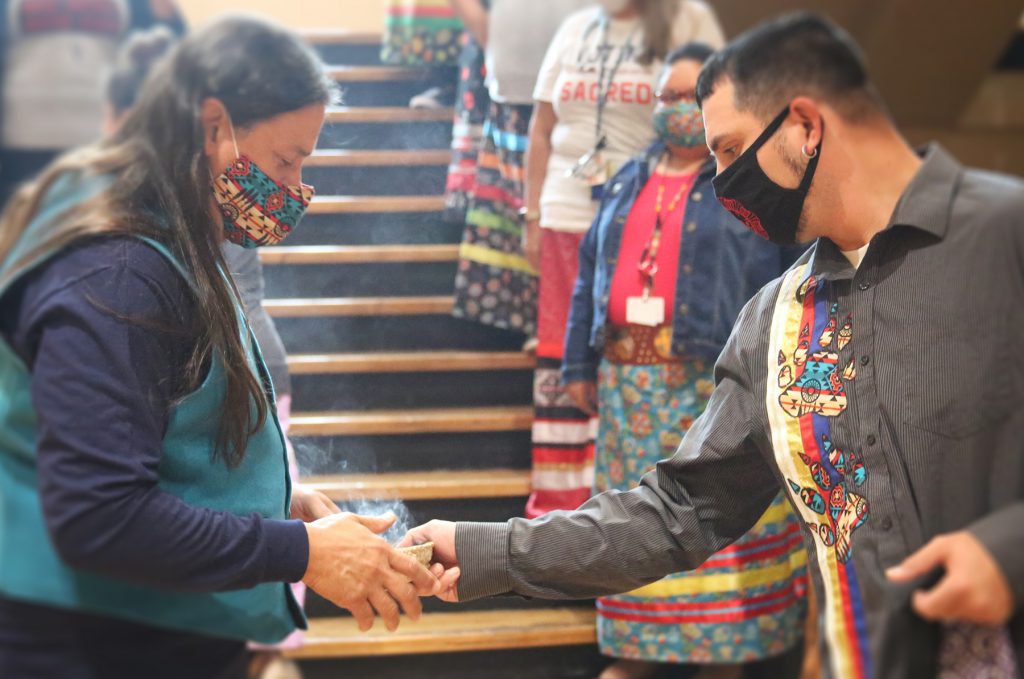Center Offers New Approach to Mental Health
Gerald L. Ignace Indian Health Center’s techniques draws on Native American culture.

Spiritual adviser Daniel Preston (left) and culture program coordinator David Powless during the Indigenous People’s Day celebration in November. Cultural events play a major role in the Gerald L. Ignace Indian Health Center’s approach to mental health services. Photo provided by Jeremiah Wayman, Gerald L. Ignace Indian Health Center/NNS.
Prayer fires. Talking circles. Bead-weaving.
These are integral and celebrated parts of Native American culture. Soon, they’ll take on another significance as staff at the Gerald L. Ignace Indian Health Center use them as part of a new culture-based approach to mental health services for the community.
The event will be the first of its kind for the center. Maria Farias, program coordinator for Ignace’s Native Connections MKE, said organizers will highlight different healing approaches for members of the community.
For example, Farias said, leaders will offer tips on how to nurture a child with a mental health disorder, how to transition from different levels of education and how to cope with stress.
The ultimate goal is to address mental health concerns while creating a sense of community, Farias said.
“A lot of times, traditional intervention by a mental health professional is very scary, very formal and very foreign for some,” said Deborah Black, director of behavioral health services at Gerald L. Ignace Indian Health Center.
It can be easier to approach someone and say, “Come meet me at this fire” and give them the opportunity to speak than to get them to talk in therapy, Black said. There is no one-size-fits-all solution, she said.
“At a craft or prayer fire, people have the opportunity to open up as they want and get comfortable with us knowing they have a certain place that they can go and be open to get help the way they need it,” Farias said.
Thursday’s program will target those from ages 15 to 24. According to Mental Health America, Native American teens aged 15-19 died by suicide at twice the rate of non-Hispanic whites. About 20% of Native Americans reported a mental illness.
It can also be difficult to get people to recognize when they need help, Farias said. Many people struggle, thinking that they won’t be heard or understood.
Thursday’s program will provide a space for being together and healing but also will stress strength, Farias said. For young men, for example, the focus will be on “restoring the warrior.”
“I want to accentuate there are significant cultural characteristics of strength and resiliency and the beliefs that are sustained within our Native community communities today, highlighting what makes us strong and not losing grasp of that,” Farias said.
What you need to know
The Mental Health Matters drive-through and walk-up event will be from 2 p.m. to 6 p.m. Thursday, June 3 at 930 W. Historic Mitchell St.
This story was originally published by Milwaukee Neighborhood News Service, where you can find other stories reporting on fifteen city neighborhoods in Milwaukee.




















I have to wonder about the effectiveness of the Gerald L. Ignace Indian Health Center. Here’s a quote from a recent Milwaukee Journal Sentinel article on COVID-19 vaccination rates among Wisconsin’s Native Americans. It is under the sub-heading “Milwaukee County lagging behind”:
Milwaukee County, where more Native Americans live than anywhere else in the state, is lagging behind other counties in inoculating its Native residents. At least 770 Native residents of Milwaukee County have been vaccinated, out of about 14,500 residents who identify as Native, according to DHS and Census figures.
That’s fewer shots than have been given to Natives in other counties with much smaller Native populations.
(Source: “Wisconsin tribes devastated by COVID-19 roll out vaccine quickly, but Native Americans’ vaccination rates still lag behind whites'” by Sarah Volpenhein, Milwaukee Journal Sentinel, March 12, 2021.)
It has been a couple of months since this report, and I hope things have improved. Nevertheless, it seems that other centers are doing a much better job of serving their constituents.